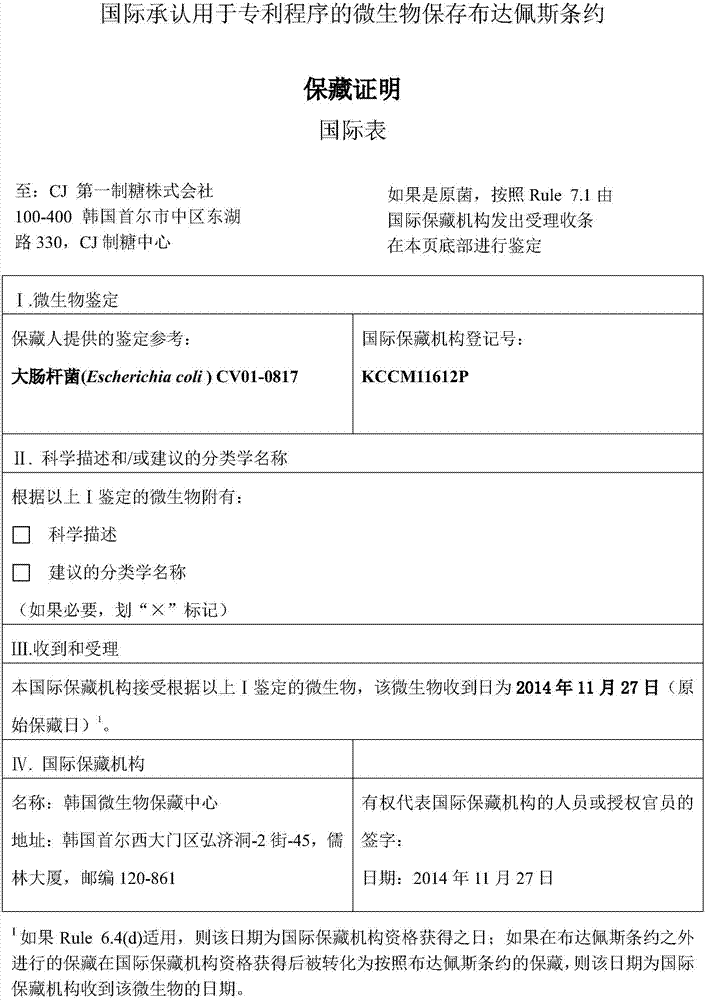Microorganism capable of producing quinolinic acid, and method for producing quinolinic acid utilizing the microorganism
A technology of microorganisms and quinolinic acid, applied in the field of microorganisms capable of producing quinolinic acid and using the microorganisms to produce quinolinic acid, which can solve problems such as the impact of oil extraction costs and environmental problems
- Summary
- Abstract
- Description
- Claims
- Application Information
AI Technical Summary
Problems solved by technology
Method used
Image
Examples
Embodiment 1
[0072] Embodiment 1. Preparation produces the bacterial strain of quinolinic acid
[0073] 1-1. Preparation of quinolinic acid phosphoribosyltransferase-depleted strain
[0074] The following experiments were performed to delete the nadC gene encoding the quinolinic acid phosphoribosyltransferase involved in the quinolinic acid degradation pathway.
[0075] The nadC gene of the quinolinic acid degradation pathway was obtained by performing PCR using the chromosomal DNA of Escherichia coli K12W3110 as a template. Nucleotide sequence information of nadC gene (NCBI accession number "GI:89106990", SEQ ID NO:4) was obtained from GenBank of National Institutes of Health (NIH), and its amino acid sequence was identical to SEQ ID NO:3. Based on SEQ ID NO: 4, the primers of SEQ ID NO: 5 and the primers of SEQ ID NO: 6 for amplifying the downstream region of nadC gene were synthesized, the primers of SEQ ID NO: 7 and the primers of SEQ ID NO: 7 for amplifying the upstream and downstrea...
Embodiment 2
[0120] Example 2. Evaluation of the productivity of quinolinic acid producing strains
[0121] To evaluate the ability of the nadA(KP) gene-enhanced strain to produce quinolinic acid, the pNadA-nadA vector and the pNadA-nadA(KP) vector were introduced into the W3110-ΔnadC strain, and the W3110ΔnadC / pNadA-nadA strain and the W3110ΔnadC / pNadA-nadA (KP) strains were named CV01-0812 and CV01-0813. Furthermore, to enhance nadB, the pPro-nadB vector was introduced into CV01-0812 and CV01-0813, and they were named CV01-0814 and CV01-0815, respectively.
[0122] Vector introduction method is using CaCl 2 Method transformation, and in the incubator of 37 ℃, CV01-0812 and CV01-0813 are in LB-Sp (10g / L yeast extract, the NaCl of 5g / L, the tryptone of 10g / L, the agar of 1.5% , 50 μg / L of spectinomycin) plate medium and culture overnight, CV01-0814 and CV01-0815 in LB-sp, Km (yeast extract of 10g / L, NaCl of 5g / L, 10g / L of tryptone, 1.5% agar, 50 μg / L of kanamycin, 50 μg / L of spectinomy...
PUM
 Login to View More
Login to View More Abstract
Description
Claims
Application Information
 Login to View More
Login to View More - R&D
- Intellectual Property
- Life Sciences
- Materials
- Tech Scout
- Unparalleled Data Quality
- Higher Quality Content
- 60% Fewer Hallucinations
Browse by: Latest US Patents, China's latest patents, Technical Efficacy Thesaurus, Application Domain, Technology Topic, Popular Technical Reports.
© 2025 PatSnap. All rights reserved.Legal|Privacy policy|Modern Slavery Act Transparency Statement|Sitemap|About US| Contact US: help@patsnap.com

